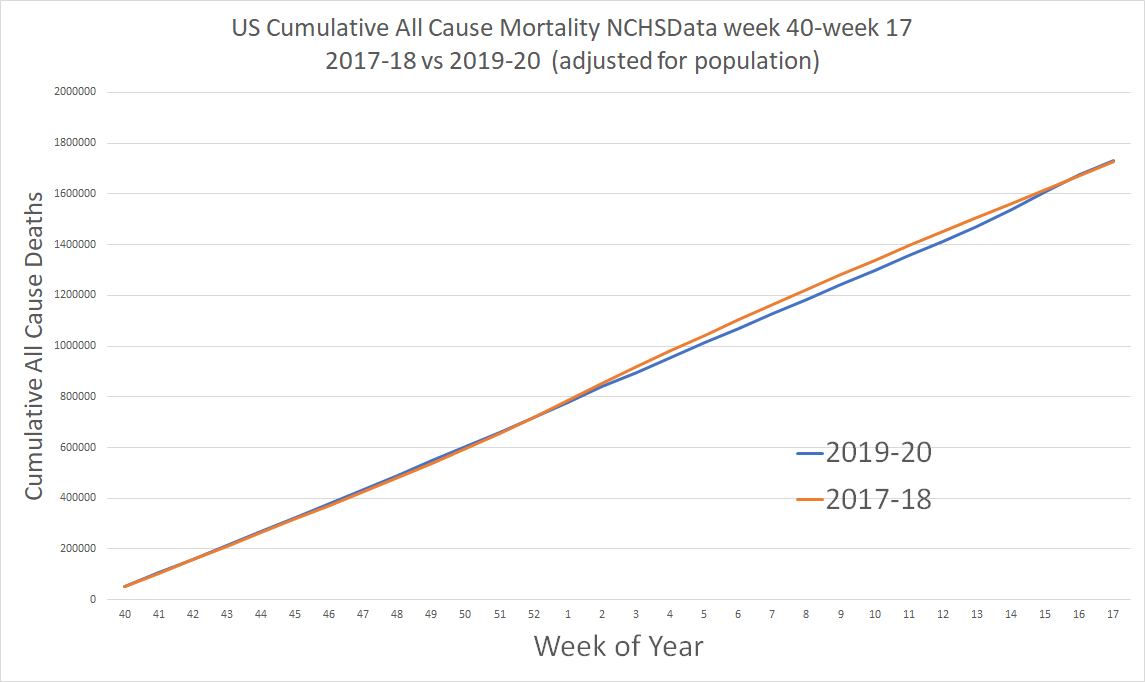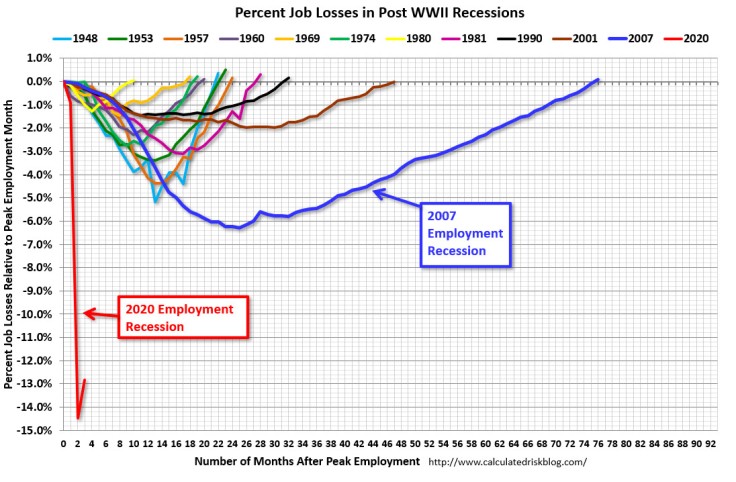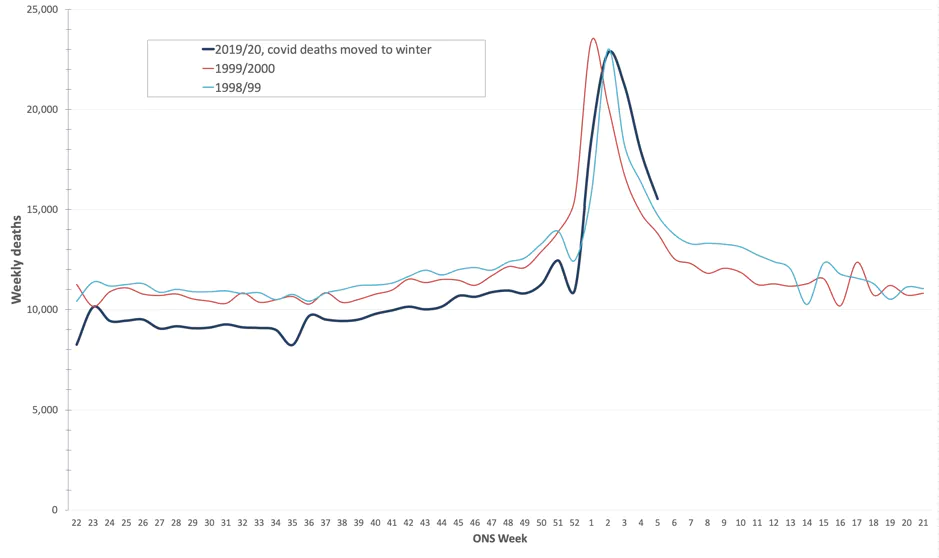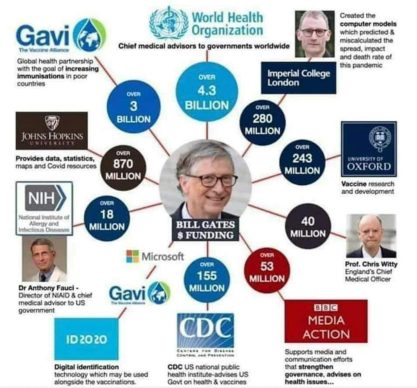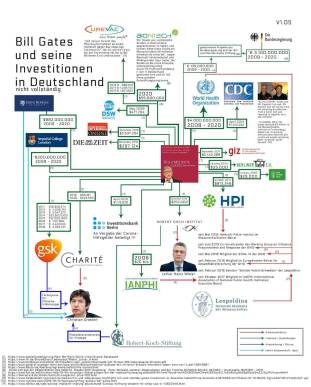Facts about Covid-19
June 2020 Update
A. General part
Studies of Covid-19 lethality
Stanford professor John Ioannidis published an overview of Covid-19 antibody studies. According to his analysis, the lethality of Covid19 (IFR) is below 0.16% in most countries and regions. Ioannidis found an upper limit of 0.40% for three hotspots.
In its latest report, the US health authority CDC reduced the Covid19 lethality (IFR) to 0.26% (best estimate). Even this value may still be seen as an upper limit, since the CDC conservatively assumes 35% asymptomatic cases, while most studies indicate 50 to 80% asymptomatic cases.
At the end of May, however, Swiss immunologists led by Professor Onur Boyman published what is probably the most important study on Covid19 lethality to date. This preprint study comes to the conclusion that the usual antibody tests that measure antibodies in the blood (IgG and IgM) can recognize at most one fifth of all Covid19 infections.
The reason for this discrepancy is that in most people the new coronavirus is already neutralized by antibodies on the mucous membrane (IgA) or by cellular immunity (T-cells). In most of these cases, no symptoms or only mild symptoms develop.
This means that the new coronavirus is probably much more common than previously thought and the lethality per infection is up to five times lower than previously assumed. The real lethality could thus be well below 0.1% and hence in the range of strong seasonal influenza.
In fact, several studies have now shown that up to 60% of all people already have a certain cellular immunity to Covid-19, which was acquired through contact with previous coronaviruses (common cold viruses). Children in particular often come into contact with such coronaviruses, which could help explain their insensitivity to Covid19.
The new Swiss study may also explain why antibody studies even in hotspots like New York or Madrid found infection rates of at most about 20%, as this would correspond to an actual rate of nearly 100%. In many regions, the actual prevalence might already be well over 50% and thus in the range of herd immunity.
Should the Swiss study be confirmed, the assessment of Oxford epidemiologist Prof. Sunetra Gupta would apply, who predicted early on that Covid-19 is very widespread and its lethality below 0.1%.
Despite the comparatively low lethality of Covid-19 (deaths per infection), the mortality (deaths per population) can still be increased regionally and in the short term if the virus spreads rapidly and reaches high risk groups, especially patients in nursing homes, as indeed happened in several hotspots (see below).
Due to its rather low lethality, Covid-19 falls at most into level 2 of the five-level pandemic plan developed by the US health authorities. For this level, only the “voluntary isolation of sick people” is to be applied, while further measures such as face masks, school closings, distance rules, contact tracing, vaccinations and lockdowns of entire societies are not recommended.
Regarding contact tracing, a WHO study on influenza pandemics from 2019 also came to the conclusion that from a medical point of view this is “under no circumstances recommended”, since it is not expedient for easily communicable and generally mild respiratory diseases.
It is sometimes argued that the rather low lethality was not known at the beginning of the pandemic. This is not entirely true, as data from South Korea, the cruise ships and even from Italy already showed in March that the risk to the general population is rather low.
Many health authorities also knew this, as leaked emails from Denmark in mid-March show: “The Danish Health Authority continues to consider that Covid-19 cannot be described as a generally dangerous disease, as it does not have either a usually serious course or a high mortality rate.”
However, some media and laypeople continue to calculate an allegedly much higher Covid19 lethality of sometimes over 1% by simply dividing deaths by “infections”. This procedure is of course not meaningful because it does not take into account the age and risk structure of the population, which is absolutely crucial, especially with Covid19.
The latest data from the European mortality monitoring Euromomo show that several countries such as France, Italy and Spain are already entering a below-average mortality. The reason for this is that the average age of Covid19 deaths was very high and fewer people than usual are now dying in this age group.
See also: Studies on Covid-19 lethality
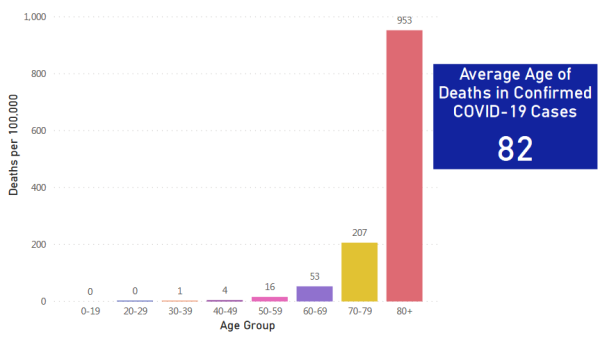 Example: Death rate per age group in Massachusetts, USA ( source )
The role of nursing homes
Example: Death rate per age group in Massachusetts, USA ( source )
The role of nursing homes
Nursing homes played an absolute key role in the Covid 19 pandemic. In most countries, one to two thirds of all Covid19 deaths occurred in nursing homes, and up to 80% in Canada and some US states. Even in Sweden, which did not impose a lockdown, 75% of deaths occurred in nursing homes and nursing flats.
It is all the more worrying that some authorities have obliged their nursing homes to admit Covid patients from the clinics, which has almost always resulted in numerous new infections and deaths. This happened in northern Italy, England and the heavily affected US states of New York, New Jersey and Pennsylvania.
It is also known from northern Italy that the widespread fear of the virus and the announced lockdown led to the flight of the predominantly Eastern European nurses, which accelerated the breakdown of elderly care.
In the United States, at least 42% of all Covid19 deaths are accounted for by 0.6% of the population living in nursing homes. Nursing homes require targeted protection and do not benefit from a general lockdown of society as a whole.
In addition, it is often not clear whether these people really died from Covid-19 or from weeks of stress and total isolation. For example, there were approximately 30,000 additional deaths in English nursing homes, but in only 10,000 cases, Covid19 is noted on the death certificate.
In April alone, around 10,000 additional dementia patients without corona infection died in England and Wales due to weeks of isolation. Investigations into the situation in nursing homes have been initiated or requested in several countries.
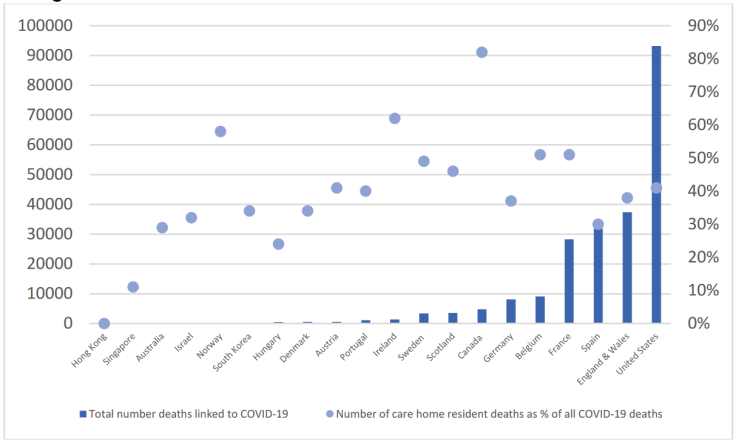 Nursing home deaths, absolute and percentage ( LTCCovid )
The role of hospitals
Nursing home deaths, absolute and percentage ( LTCCovid )
The role of hospitals
The second central factor regarding infections and deaths, in addition to the nursing homes, are the hospitals themselves. A case study in Wuhan already showed that around 41% of hospitalized Covid patients had in fact contracted Covid in the hospital itself.
Contagion in hospitals also played a decisive role in northern Italy, Spain, England and other regions that were severely affected, meaning that the clinics themselves became the main place of transmission of Covid19 to already weakened people (so-called nosocomial infection) – an issue that had already been observed during the SARS outbreak from 2003.
Based on current knowledge, those countries that managed to avoid outbreaks of infection in nursing homes and hospitals had comparatively few deaths. The general lockdown, however, played no or a even a counterproductive role (see below).
It is well known that even common corona viruses (cold viruses) can be very dangerous for people in nursing homes. Stanford professor John Ioannidis pointed out already in mid-March that coronaviruses may have a case mortality rate of up to 8% in nursing homes.
The clinical picture of Covid-19
The well-known Hamburg medical examiner Professor Klaus Püschel presented his study (English) on the first 12 of 190 detailed corona autopsies at a press conference (German).
Professor Püschel again emphasized that Covid-19 “is not nearly as threatening as was initially suspected”. The danger was “too much influenced by media images”. The media had focused on severe individual cases and fueled panic with “completely wrong messages”. Covid-19 is not a “killer virus” and the call for new medicine or vaccines is “driven by fear, not facts.”
The specific cause of death of the examined cases was pneumonia, but in about 50% of the cases there were venous thrombosis in the legs, which can lead to fatal pulmonary embolism. The kidneys and heart muscle were also partially affected. Professor Püschel therefore recommends the preventive administration of blood-thinning medication for serious Covid cases.
With regard to thrombosis and pulmonary embolism, Professor Püschel – like other experts before – emphasized that a “lockdown” with quarantine at home was “exactly the wrong measure”, since the lack of exercise also promotes thrombosis. Indeed, US specialists have alread been warning of this risk after even Covid-negative people developed unexpected thrombosis.
Many media again misinterpreted the autopsy findings and spoke of Covid-19 as a dangerous “multi-organ disease” which, unlike influenza, is said to lead to thrombosis and pulmonary embolism. This is, of course, wrong: it has been known for 50 years that even severe influenza can greatly increase the risk of thrombosis and embolism and can affect the heart muscle and other organs. Even the recommendation regarding preventive blood thinner for severe influenza has been around for 50 years already.
Children and schools
Numerous studies have now shown that children hardly get Covid19 and do not or hardly transmit the virus, which was already known from the 2003 SARS outbreak. There was therefore no medical reason for the closure of schools at any time.
Accordingly, all those countries that reopened their schools in May saw no increase in cases of infection. Countries like Sweden, which never closed their primary schools anyway, had no problems with this either.
A preprint study by the German virologist Christian Drosten argued that the risk of infection from children is comparable to adults and schools should therefore remain closed. However, several researchers demonstrated methodological errors in the study. Drosten subsequently withdrew the recommendation regarding school closures.
In some schools, for example in France and Israel, alleged “corona outbreaks” are said to have occurred. However, it is likely that these are transmissions from teachers to schoolchildren that, to their dismay, are regularly tested, although they hardly show any symptoms and are themselves hardly or not at all contagious.
The British Kawasaki Disease Foundation again criticized the dubious and lurid media coverage of Kawasaki disease. In fact, there has been no significant increase in Kawasaki cases and no proven association with Covid-19. General inflammatory reactions in individual children are also known from other viral infections, but the number of cases reported so far is extremely low.
German medical associations have also given the all-clear: Covid-19 is imperceptible or very mild in almost all children. Schools and daycare centers should therefore be opened immediately and without restrictions, ie there is no need for small groups, distance rules or masks.
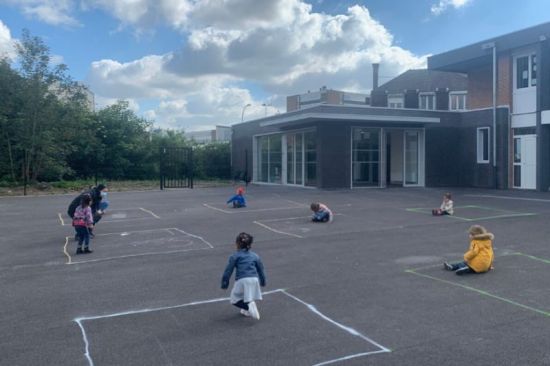 Schoolchildren in France who have to play in boxes (May 15, 2020, DailyMail )
On the effectiveness of masks
Schoolchildren in France who have to play in boxes (May 15, 2020, DailyMail )
On the effectiveness of masks
Regardless of the comparatively low lethality of Covid19 in the general population (see above), there is still no scientific evidence for the effectiveness of masks in healthy and asymptomatic people in everyday life.
A cross-country study by the University of East Anglia came to the conclusion that a mask requirement was of no benefit and could even increase the risk of infection.
Two US professors and experts in respiratory and infection protection from the University of Illinois explain in an essay that respiratory masks have no effect in everyday life, neither as self-protection nor to protect third parties (so-called source control). The widespread use of masks didn’t prevent the outbreak in the Chinese city of Wuhan, either.
A study from April 2020 in the journal Annals of Internal Medicine came to the conclusion that neither fabric masks nor surgical masks can prevent the spread of the Covid19 virus by coughing.
An article in the New England Journal of Medicine from May 2020 also comes to the conclusion that respiratory masks offer little or no protection in everyday life. The call for a mask requirement is described as an “irrational fear reflex”.
A May 2020 meta-study on pandemic influenza published by the U.S. CDC also found that respirators had no effect.
The WHO moreover declared in June that truly “asymptomatic transmission” is in fact “very rare”, as data from numerous countries showed. Some of the few confirmed cases were due to direct body contact, i.e. shaking hands or kissing.
In Austria, the mask requirement in retail and catering will be lifted again from mid-June. A mask requirement was never introduced in Sweden because it “does not offer additional protection for the population”, as the health authority explained.
Numerous politicians, media people and police officers have already been caught putting on their respirators in a crowd especially for the television cameras or taking them off immediately when they believed that they were no longer being filmed.
In some cases there were brutal police attacks because a person allegedly “did not wear her mask properly”. In other cases, people with a disability who cannot and do not have to wear a mask, are not allowed to enter department stores .
Despite this evidence, a group called “masks4all”, which was founded by a “young leader” of the World Economic Forum (WEF) Davos, is advocating worldwide mask requirements. Several governments and the WHO appear to be responding to this campaign.
Many critics suspect that the masks are more likely to have a psychological or political function (“muzzle” or “visible sign of obedience”) and that wearing them frequently might even lead to additional health problems.
On the origin of the virus
In mid-March, some researchers argued in a letter to the journal Nature Medicine that the Covid19 virus must be of natural origin and not “from a laboratory”. They cited the structure of the virus and the fact that the binding to the human ACE2 cell receptor did not correspond to the theoretical maximum.
In the meantime, however, numerous renowned virologists have contradicted this argument. An artificial origin in the context of virological functional research is “at least as plausible” as a natural origin. In fact, coronaviruses of this kind have been intensively researched in several laboratories for almost 20 years (i.e. since the SARS outbreak in 2003), they say.
Arguments in favour of an artificial origin include in particular that the binding to the human ACE2 cell receptor is significantly stronger than in all common source animals and that no direct source animal could be identified so far. In addition, the virus contains some striking functional gene sequences that might have been inserted artificially.
The initial theory of the animal market in Wuhan has since been rejected because none of the animals there tested positive and a third of the very first patients had no connection to the animal market. The animal market is now seen as a secondary place of transmission.
It is known that the virological laboratory in Wuhan, in collaboration with the United States and France, researched coronaviruses and thereby also generated “potentially pandemic pathogens” (PPP) that are particularly easy to transmit and / or particularly dangerous. In addition, there have been several laboratory accidents with virus releases in China and the USA.
The unbiased observer must therefore continue to consider several realistic options: a natural origin of the virus (as assumed with SARS 2003), a laboratory accident as part of functional research (probably in Wuhan), or even a targeted release by a geopolitically interested actor in the East or West.
Nevertheless, the Covid19 virus is not a “biological weapon” in the classic sense: the virus is very easily transmissible, but not particularly dangerous for the general population. Animal studies have shown that much more deadly corona viruses can be generated.
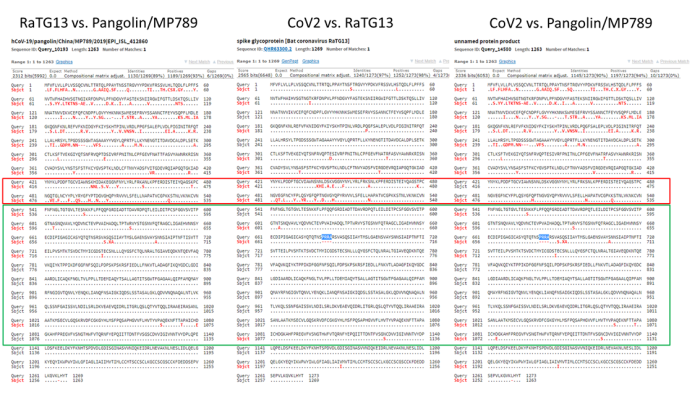 Comparison of coronavirus amino acid sequences (Yuri Deigin)
Vaccines against Covid-19
Comparison of coronavirus amino acid sequences (Yuri Deigin)
Vaccines against Covid-19
Numerous experts have already pointed out that an express vaccine against the new coronavirus is not necessary or useful due to the overall low lethality (see above) and the already declining spread. The protection of risk groups, especially in nursing homes, could be much more targeted.
Some experts like the Swiss infectiologist Dr. Pietro Vernazza also pointed out that experience shows that the high-risk group in particular benefits the least from vaccination, since their immune system no longer reacts adequately to the vaccine.
Various experts have also pointed out the significant health risks of an express vaccine. In fact, vaccination against the so-called “swine flu” from 2009/2010, for example, led to sometimes severe neurological damage, particularly in children, and to claims for damages in the millions.
Nevertheless, several billion dollars of private and public funds have already been collected for the development of a vaccine. An “immunity certificate” for work and travel is still being discussed. However, contrary to most media reports, the two leading vaccine projects had some serious complications.
In the case of the Oxford University vaccine, in animal experiments all six rhesus monkeys fell ill with Covid19 despite vaccination and were as infectious as the unvaccinated monkeys. Nevertheless, the vaccine was moved on to the human test phase. However, the project manager explained that the coronavirus had already become so rare in the population that the clinical trial may deliver no result.
In the case of the novel RNA vaccine from Moderna, which was unusually tested directly in human experiments, 20% of the participants in the high-dose group had a “serious side effect”, although Moderna only allowed very healthy people to try it.
One of the Moderna participants was then presented and interviewed by CNN as a “hero”. However, it was agreed not to mention that the participant passed out after the vaccination and became “as sick as never before in his life”. Several experts also criticized Moderna for not disclosing their clinical data sufficiently.
The director of the US Corona Vaccine Rapid Development Program was himself previously a director at Moderna. President Trump also announced that the vaccine might be distributed nationwide with the U.S. military. Some countries, such as Denmark, have already created the legal basis for mandatory vaccination of the entire population. In Germany, too, various politicians have spoken out in favor of compulsory vaccination.
Proponents of compulsory vaccination, such as World Medical President Frank Montgomery, argue that the population must be vaccinated to protect those who cannot be vaccinated for health reasons. In view of the rather low lethality of Covid19 and the already wide prevalence, this argumentation seems rahter questionable, however. In addition, there are the serious vaccine risks outlined above.
Nevertheless, the head of the largest European ticket portal Eventim said that “major events may not return until there is a vaccine or a correspondingly effective medication.”
British Prime Minister Boris Johnson, who co-chaired the vaccine summit in early June with US billionaire Bill Gates, described the GAVI vaccine alliance as a kind of “health NATO”.
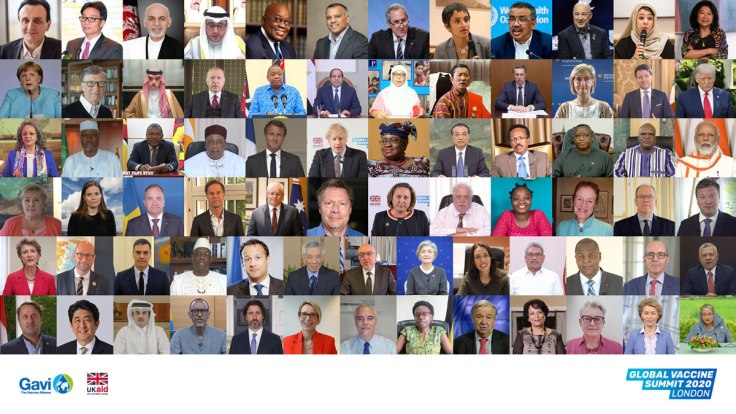 Heads of government at the global vaccine summit on June 4, 2020 ( GAVI )
Medication against Covid-19
Heads of government at the global vaccine summit on June 4, 2020 ( GAVI )
Medication against Covid-19
The situation regarding helpful medication for severe Covid19 cases remains very unclear. The only consensus is that blood thinners are helpful in preventing life-threatening thrombosis and embolism (as with severe influenza).
There have been fierce discussions about the malaria drug hydroxychloroquin (HCQ) for months. The journal Lancet published a study at the end of May according to which HCQ leads to heart problems. The WHO then ceased all of its HCQ studies. Shortly thereafter, however, it became known that the Lancet study was based on a manipulated data set.
The Lancet study and another study in the New England Journal of Medicine (NEJM) had to be withdrawn, which is one of the biggest medical scandals in recent years. The reason for the manipulated study is not clear, however, the lead author seems to be involved in a study of competing drug Remdesivir at the same time.
The use of remdesivir by the pharmaceutical company Gilead came itself under pressure after a first study showed that the drug could not reduce the risk of death. However, many media ignored this and still reported positive about the drug.
A former French Minister of Health revealed in an interview that the editors of Lancet and NEJM stated in a confidential discussion panel that the pressure and influence of pharmaceutical companies had become so great that one could no longer speak of science. Both editors are said to have used the term “criminal” to describe the current situation.
Various clinics use or study HCQ in Covid19 patients, sometimes in combination with zinc, vitamins or other medications. However, it is known that HCQ can lead to fatal complications in the metabolic peculiarity of favism, which occurs particularly in people from Africa and the Mediterranean region.
Unfortunately, it must be assumed that incorrect or too aggressive medication with HCQ, steroids, antibiotics and antiviral agents as well as invasive ventilation during the corona pandemic has led to numerous additional and avoidable deaths.
Expert opinions (selection)
- The British chief physician Dr. Chris Witty said in a lecture that Covid19 posed “no danger to the majority of the population”. Most people would not or only mildly fall ill with it, and even with those who are seriously ill, the chances of recovery are good.
- Stanford professor and Nobel Laureate in Chemistry Michael Levitt explains in a new post that the lockdowns did not save lives but cost many. A “panic virus” has spread among politicians worldwide, professor Levitt said.
- Professor Karel Sikora of the University of Buckingham argued in an interview that ultimately, fear will “kill a lot more people than the virus,” including untreated heart and cancer patients. Schools should be opened quickly and masks should remain an individual decision because their benefits have not been proven. One should go back to an “old normal” and not a “new normal”. (Note: The video with Professor Sikora was temporarily deleted by YouTube and only reactivated after protests).
- Professor Yoram Lass, former director-general of Israel’s Ministry of Health, argues that the lockdown measures have been “totally disproportionate” and are an acute threat to hundreds of millions of people. Covid19 is comparable to a flu epidemic and would never have justified such political destruction of livelihoods. People have been intimidated and “brainwashed”.
- The Oxford professor of epidemiology, Sunetra Gupta, argues in a new interview that the lethality of Covid19 is likely to be below 0.1% and that a large number of people have already come into contact with the virus.
- Leading German virologist Dr. Hendrik Streeck criticized the lockdown and explained that “all experts are returning to the assessment of the early days” that Covid-19 “should not be trivialized, but also should not be dramatized”. The reason for the declining risk assessment was the “enormous number of infections that remained without symptoms”. Streeck does not expect any excess mortality in Germany by the end of the year, as the average age of death is “rather above life expectancy”, and he doesn’t consider “corona apps” and widespread corona tests to be useful. He also criticized the general use of masks, saying that these are a “wonderful breeding ground for bacteria and fungi”. Schools should be reopened as soon as possible.
- An employee of the German Ministry of the Interior, responsible for disaster protection, together with external experts wrote a 100-page analysis paper on corona crisis management, which was leaked to the press at the beginning of May and created strong reactions. In the paper, Covid-19 is described as a “global false alarm” because “there was probably at no time a risk beyond the normal level” for the general population. The collateral damage caused by the lockdown is now significantly higher than the recognizable benefit and far exceeds the risk potential of the corona virus. In March and April alone, over a million operations were not carried out in Germany. The data supplied by the official RKI were “not reliable” as the basis for decision-making. The official was subsequently fired because he had created the paper “without authorization”.
- A group led by Professor Sucharit Bhakdi founded the Association of Physicians and Scientists for Health, Freedom and Democracy (MWGFD), which has already been joined by over 16,000 supporters. At the beginning of June, the group published a call to the federal government and all state governments to immediately and completely lift the Corona measures imposed. Professor Bhakdi’s book, Corona: A False Alarm?, appearing at the end of June, is already an Amazon bestseller solely due to the pre-orders.
- A senior physician for intensive medicine at the University Hospital Zurich, who cared for critical Covid 19 patients, criticized in a widely shared video the “scaremongering” associated with the disease. For the vast majority of all people there is no significant risk of death, the numbers are comparable overall to earlier flu waves. Risk groups could be protected in a targeted manner, while the lockdown only prevents the immunization of the general population. In addition, people die due to the medical undersupply in other areas. The medical and social damage has long been greater than the benefits. The partially mandatory mouth protection for schoolchildren also has “no medical sense and benefit” and places a heavy burden on the children. The “daily counting” of the cases is nonsensical and only spreads fear. The counterproductive measures must be stopped quickly.Swiss media tried to put pressure on the Zurich University Hospital after the video had been widely distributed. The doctor has since removed the original video.
- The Swiss chief physician for infectiology, Dr. Pietro Vernazza, using current case studies as an example, explains that fever measurements and contact tracing are not useful due to the often symptom-free course and easy transmission of Covid19.
- The well-known Swiss immunologist Dr. Beda Stadler explains in an article that Covid19 is a “very selective disease” and only poses a real risk for very few people. The media, on the other hand, focused on the few atypical individual cases that exist with every illness. Many scientists had focused too much on their models and too little on reality. The planned contact tracing is medically “senseless” and spreads “only panic”.
- Overview: 250 worldwide expert voices against corona dogmas (German)
Success stories
Sweden: Sweden had no lockdown, no mask requirement and no primary school closures, but mainly relied on the personal responsibility and cooperation of the population. This approach worked well and Sweden saw only a low mortality rate in the general population comparable to a strong seasonal flu wave.
Nevertheless, the overall mortality rate was indeed higher than in the neighboring Scandinavian countries or Germany and is comparable to that in England. The real reason for this, however, is that around three quarters of Swedish deaths occurred in nursing homes and nursing flats. The median age of Swedish Covid deaths (86) is probably the highest in the world.
The Swedish government apologized for the insufficient protection of nursing patients and announced an investigation. Many media tried to present this as an alleged “failure of the no-lockdown strategy”, but nursing homes need targeted protection and do not benefit from a general lockdown.
Moreover, even total mortality in Sweden has remained below the strongest seasonal flu waves of the past thirty years. In addition, Sweden may now benefit from a very high natural immunity, especially considering the latest studies on the actual range of antibody tests (see above).
Florida: Despite numerous senior citizens, Florida introduced minimal restrictions and no general lockdown, even the popular beaches were reopened early, which was heavily criticized by many US media. Nevertheless, Florida did very well compared to other states and recently had around 2300 deaths in a population of 21 million, which corresponds to Germany’s mortality.
In an interview, the governor explained that contrary to the media, he realized early on based on the figures from South Korea and Italy that Covid19 was only dangerous for a very small risk group and he therefore protected the nursing homes as best as possible. In terms of prevention, nursing homes were even more important than the clinics themselves, and this strategy had proven itself. At the end of May, the governor announced that summer camps and youth activities could be carried out without restrictions.
Japan: Japan registered some of the first Covid19 cases outside of China, but did not introduce a lockdown. At the end of March, the Japan Times asked, “Where’s the coronavirus explosion?” Bloomberg now reports that a corona crisis never materialized: there were no restrictions on movement, restaurants and hairdressers remained open, there were no “tracking apps” and no mass tests of the general population. Nevertheless – or because of this – Japan now has by far the least deaths compared to the G7 industrialized countries.
It is sometimes argued that the respirators were decisive for Japan’s success. However, respirators are voluntary in Japan and did not stop the outbreak in the Chinese city of Wuhan, while Sweden, Florida and other successful regions did not use masks in the general population.
Belarus: Belarus has probably implemented the least restrictions of all industrialized nations and carried out even major events such as the 75-year celebrations of the end of World War II. Nevertheless, Belarus officially counts fewer than 300 Covid deaths even after more than three months. Long-term President Lukashenko, who has repeatedly referred to Corona as a “psychosis,” said in mid-May that the capital, Minsk, had already passed the peak. The decision to treat Covid19 cases like normal pneumonia was correct. Ultimately, however, only statistics on overall mortality will be able to show whether the Belarusian numbers are really correct.
 A Florida beach during the Corona pandemic (NBC)
Additional Notes
A Florida beach during the Corona pandemic (NBC)
Additional Notes
- Transmission routes: A new report by the US health agency CDC comes to the conclusion that the virus is transmitted primarily through direct contact with people and “cannot spread easily on surfaces.” The German virologist Hendrik Streeck was already able to demonstrate that the new corona virus does not or hardly spread through objects or through aerosols floating in the air.
-
- Distance rules: Iceland declared the distance rules optional at the end of May and reopened bars and clubs. Switzerland converted the distance regulations into a voluntary recommendation. A Cochrane study from 2011 already showed that there is so far hardly any evidence for the effectiveness of “social distancing” measures.
-
- Surgeries: According to an article in the British Journal of Surgery, around 28 million surgeries, including many cancer surgeries, have been canceled or postponed worldwide over 12 weeks due to corona measures.
-
- Years of life: An evaluation by four US professors comes to the conclusion that the lockdown in the USA will cost about twice as many years of life as Covid-19 and was therefore a very counterproductive measure even from a purely medical point of view.
-
- Coronavirus season: A new study in the Journal of Infectious Diseases shows that coronaviruses occur “sharply seasonal” between December and April / May.
-
- Virus test: A German mathematician explains why the low remaining infection numbers in many countries consist largely of false positive results, even with fairly accurate PCR tests, and the pandemic thus “never seems to end”.
-
- “Second wave”: Studies on a “second wave” sometimes make completely unrealistic assumptions, such as a constant risk of infection and death across all age groups. Nevertheless, the example of the 1968 Hong Kong flu shows that the global spread of pandemics can indeed extend over several seasons.
-
- Italy: Almost 5% of the population in Milan already had antibodies against Covid19 in mid-February, ie before the outbreak of the epidemic in Italy. This again indicates that the virus was already circulating in Europe earlier than previously thought.
-
- Unemployment: The International Labor Agency ILO expects that due to the political corona measures, half of the world’s employees or 1.6 billion people are at risk of losing their livelihoods.
-
- Fact check: 13 misleading and false claims about the corona epidemic (German)
-
- Review: Why life went on as normal during the global flu pandemics of 1968/1969 (Hong Kong flu, and the Woodstock music festival) and of 1957 (Asian flu).
The role of the media
Most traditional media, almost all of which are part of elite geopolitical networks, decided to run a campaign of fear during the coronavirus period, a behavior that is usually observed in connection with wars of aggression or alleged terrorist attacks.
The risk to the general population was greatly exaggerated, official policies were hardly questioned, the situation in hospitals was dramatized, manipulative images were used, campaigns were staged, and protesters were systematically defamed as “idiots”.
It is true that some conservative media criticized the economically harmful lockdown measures. The real question, however, is whether they will also criticize the surveillance measures now planned, such as the extensive societal contact tracing (see below).
Most independent media sooner or later realized that the risk of the corona virus was exaggerated and politically exploited. Only a few independent media outlets did not realize this, perhaps because they lacked a medical background or fell for the official campaign of fear.
Some analysts compared Covid-19 to a psychological operation that uses the media-induced fear of the virus to bring about political and social change.
US platforms such as Google, Youtube, Facebook and Twitter censored corona issues extensively by deleting critical (i.e. non WHO compliant) points of view even from doctors or restricting their distribution, a procedure that has long been the norm for geopolitical issues.
However, modern media users have the option of using manipulation-free search engines such as DuckDuckGo and independent video platforms such as Bitchute, as well as generally using an advertising and tracking blocker on certain media sites.
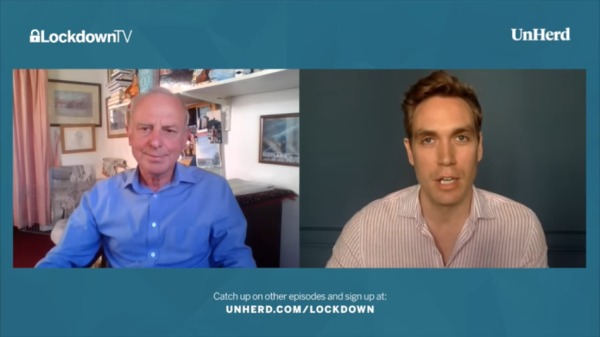 A contrarian interview with Prof. Karel Sikora that was temporarily deleted by Youtube (Unherd)
Political developments
A contrarian interview with Prof. Karel Sikora that was temporarily deleted by Youtube (Unherd)
Political developments
Numerous observers have already drawn attention to the fact that the predominantly politically induced “corona crisis” is or could be instrumentalized for far-reaching social and economic changes.
In March, NSA whistleblower Edward Snowden warned that governments are using the temporary corona crisis as an occasion or pretext for the permanent expansion of social surveillance and control, thereby establishing an “architecture of oppression”.
The measures currently being discussed or already implemented include in particular:
- The introduction of applications for society-wide contact tracing
- Building units to enforce tracing and isolation of citizens
- The introduction of digital biometric ID cards that can be used to control and regulate participation in social and professional activities.
- The expanded control of travel and payment transactions (e.g. cash abolition).
- The creation of legal foundations for access to the biological systems of citizens by governments or corporations (through so-called “mandatory vaccinations”).
More than 600 scientists have warned of an “unprecedented surveillance of society” through problematic apps for “contact tracing”. In some countries, such “contact tracing” is already carried out directly by the secret service. In several parts of the world, the population is already being monitored by drones and facing serious police overreach.
In May, Apple and Google added a contact tracing interface to the operating systems of three billion cell phones that can now be used by national authorities.
This is despite the fact that a recent WHO study on pandemic influenza came to the conclusion that contact tracing is not sensible from a medical point of view and is “not recommended in any circumstances”, as the epidemiological benefits of such apps remain doubtful.
It is often argued that the contact tracing applications would remain “voluntary” and “compliant with data protection”. However, in practice, neither is really true.
In several countries, the use of the applications is already mandatory for certain activities. Various employers, administrations, landlords and transport companies in India require the tracing app. In Argentina, everyone who is in the “public space” must activate contact tracing.
Some German politicians already advocated a preference for app users when traveling or dining out. The Israeli Prime Minister Netanyahu, for his part, spoke of the use of “sensors” for distance control in children.
In Singapore, the “voluntary” app was installed by fewer people than expected, which is why the government now wants to make it mandatory for certain public spaces and services. In some parks, the distance control is already monitored by DARPA robots.
In Australia, people who do not want to use the contact tracing app are insulted by the media as idiots and a danger to the public, and are thus put under social pressure.
The data protection of the supposedly “decentralized” contact tracing is also problematic. The Dutch IT professor Jaap-Henk Hoepmann already explained in April that even supposedly decentralized solutions can very easily be used for monitoring and surveillance.
Due to the speed of the introduction, the President of the German Society for Computer Science suspected that the functions “had long been in the devices” and only a little “fine tuning” was required. He sees the apps as a “Trojan horse”.
In parallel to the introduction of the applications, many countries have started to set up special units to track contacts and isolate citizens.
In the United States a 100 billion-dollar legislation to set up a national “Corona testing and tracing corps” with up to 180,000 members has been proposed. The states of New York and California are already building “contact tracing armies” with up to 20,000 members each. In the state of Washington, the National Guard is to participate and those who do not cooperate “voluntarily” can be forced to do so.
Italy has announced the creation of a corps with 60,000 volunteers, and Switzerland and other countries have also started building such units. In Germany there have already been mass tests in residential buildings under the threat of police coercion.
The software for society-wide contact tracing in the USA, Great Britain and possibly in other European countries is provided by the CIA-related technology company Palantir of US billionaire Peter Thiel. In Israel, contact tracing software from notorious cyber spy company NSO is used.
A whistleblower who took part in a training program for contact tracers in the United States described it in a video interview as “totalitarian” and a “danger to society”.
All these measures are taken despite the fact that the epidemiological benefit remains unclear and that the WHO explicitly opposed contact tracing, which is otherwise used mainly for serious sexual diseases or food poisoning, which, unlike common respiratory diseases, are easy to trace.
In addition to applications and special units for contact tracing, there are also specific projects or plans for “immunity cards”, which could be used, for example, to control the travel and work activities of the population. In fact, the EU had been planning to introduce such a vaccination certificate since 2018.
Such “vaccination cards” are in turn linked to a worldwide “vaccination program”, which is also currently being worked on. For example, US billionaire and vaccine investor Bill Gates called for corona vaccination for “seven billion people”. AstraZeneca is currently preparing to produce two billion doses of the still untested Oxford vaccine.
From a strategic point of view, such a global vaccination programme would provide access to the biological systems of the population, in particular the immune and nervous systems and the genetic and reproductive systems.
In the economic area, there is a surge in digitization and centralization in favor of a few US technology corporations, as the American National Security Commission on Artificial Intelligence (NSCAI), led by former Google CEO Eric Schmidt, demanded in a strategy paper in 2019 to be able to compete with China.
The World Economic Forum (WEF) Davos, which together with the Gates Foundation and Johns Hopkins University already ran the well-known coronavirus pandemic exercise “Event 201” in October 2019, called for a global “Great Reset” in order prepare the economic and social structures for the 21st century.
Meanwhile, several cardinals and bishops of the Catholic Church warned in an open letter that, under the pretext of the coronavirus, a worldwide panic had been triggered to introduce unacceptable forms of global surveillance and control of the population.
The idea that a pandemic can be used to expand global monitoring and control is not new. As early as 2010 the American Rockefeller Foundation described in a working paper on future technological and social developments a “lockstep scenario” in which the present-day developments were anticipated with surprising accuracy (from page 18).
But there are also reactions from the population: Spain, Italy and Germany, for example, have seen demonstrations for fundamental rights with thousands or tens of thousands of people.
Creative contributions
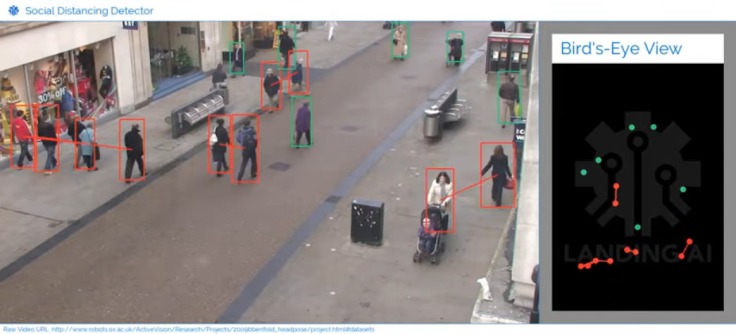 The Landing AI Social Distancing Detector (Youtube)
The Landing AI Social Distancing Detector (Youtube)
































 This topic is locked
This topic is locked



















